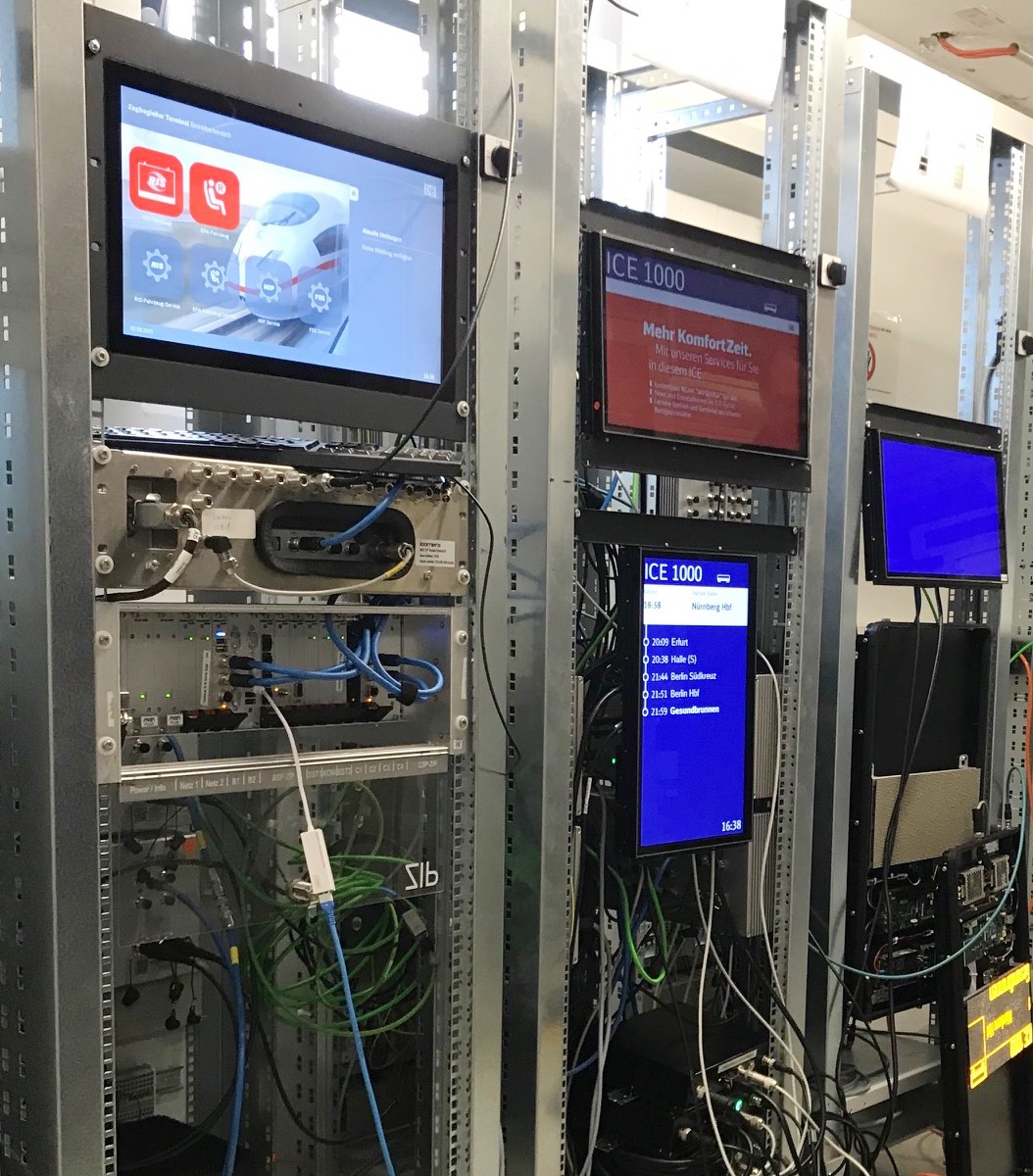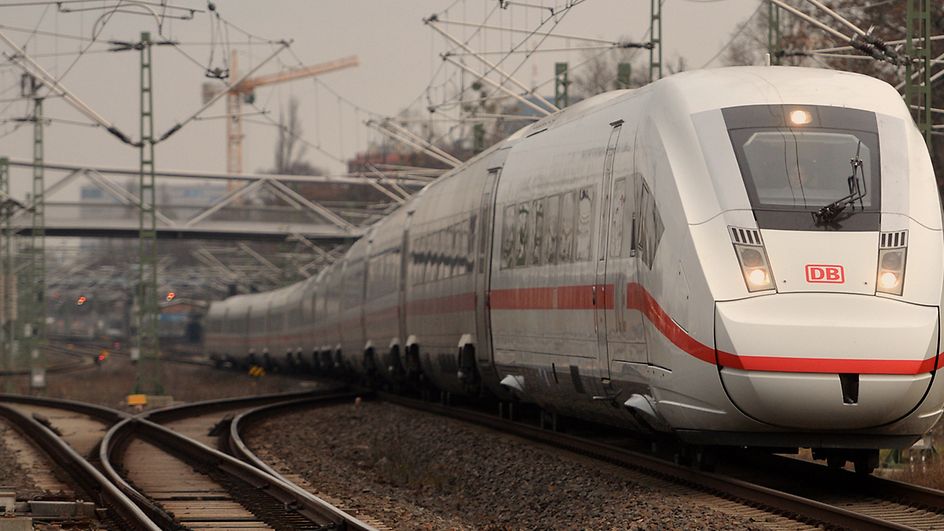Digitalisation of the ICE fleet
Article: The rolling data centre
03/2020 – Deutsche Bahn will in future use ITonICE for its ICE fleet. This vendor-independent vehicle IT will ensure the future of the "smart railway" for long-distance services.
The ICE is one of the world’s most modern and sophisticated trains. In effect, it’s a supercomputer travelling through Germany at up to 300 km/h. Numerous electronic components, transmitters, receivers, sensors and computers are on board. “We used to order trains from the manufacturer all-inclusive; they supplied all the IT”, says Nora Guthoff, operational project manager of ITonICE, the project aimed at renewing the IT in the trains. And as a result, the train IT comprises a host of very different systems and service offerings. “We have around 40 suppliers, teams and partners that we have to coordinate, giving rise to very different technical characteristics. And in turn all these systems and services have to be updated manually where necessary. That’s inefficient when you’re dealing with modern communication standards. Such an approach is also time-consuming for staff and is very prone to error.” Ultimately, any solution should not only reduce the staff workload. It should also offer passengers a compelling travel experience with improved digital services.
In the past, the train’s entire IT was controlled via the manufacturer’s IT area – referred to as the “manufacturer area” – regardless of whether that involved essential functions (accelerating, braking, and closing doors) or simply displaying the departure time. This meant that even minor adjustments or updates had to be coordinated in a drawn-out process. One reason was that the German Federal Railway Authority (EBA) must approve safety-critical changes. “The ITonICE platform lets us separate DB’s own operator area from the manufacturer area. That way we can offer new convenience functions faster or modify existing functions, independently of the safety functions associated with the train hardware”, explains André Knapmöller, responsible at DB Systel for the IT on board the trains. “So we can update the software on the train without having to bring the train into the depot.
Amicable separation
The manufacturer area is demarcated from the new IT platform with a “data diode”, also known as an instrumentation and control decoupling gateway. Information can be read from the manufacturer area, but there is no way of accessing the manufacturer area via the new IT infrastructure – both areas are securely separated from each other. This ensures high flexibility, improved working conditions for staff, while also improving the customer experience as new services can be rolled out or updated faster over the air. ITonICE will in future enable virtually any number of new services to be installed on the ICE in a very short period, almost like apps on a smartphone.
"ITonICE lets us turn every ICE into a data centre with a cloud connection."

The aim is to provide the entire fleet with a state-of-the-art communications environment for recording and transmitting real-time information. “We’d like to see real-time information and analysis results recorded and collected rapidly and automatically wherever possible. ITonICE lets us turn every ICE-class train fitted with this technology into a data centre with a cloud connection. This enables us to create our own rolling data centre fleet”, says Nora Guthoff. To provide staff with rapid, secure data access, the DB Cloud is used with the IT platform. Computers, networks and storage units are virtualised in the cloud due to the lack of space on the train and, in particular, the harsh on-board conditions, such as temperature fluctuations and vibrations.

Standard hardware rather than stand-alone solutions
The ICE trains run the length and breadth of Germany at high speeds – the mobile reception is patchy in some areas. For that reason the trains are fitted with a series of additional antennas to improve connections with the IT in the DB Cloud. At the same time, this substantially improves Wi-Fi stability for customers who can surf the web with fewer interruptions. To deliver this enhanced customer experience, the existing hardware on the first ICE classes will be updated in line with the state of the art on a modular basis by late 2024. Thanks to the vendor-independent infrastructure, the envisaged solution can use off-the-shelf standard components flexibly.
Nonetheless, the time and effort involved in retrofitting is considerable and is always slightly different for each class. “The planning is very complex since you’re not only looking at lots of trains, but lots of people are involved too”, says Nora Guthoff. “With the ICE 4 where we receive delivery of a new train every three weeks, some of these new trains are being modified right from delivery.” With the other classes, a check is done to establish where a modernisation project is planned in parallel. That way we can get on board trains in the depot, for instance in the downtimes during the redesign and overhaul of the ICE 3. It is crucial for everyone involved to manage the conversion work wherever possible without reducing the availability of trains for passenger services. “We need to pull off a balancing act in the depot”, says André Knapmöller. “On one hand, we want to manage the IT part as independently as possible. But then, on the other, we only have a small time window to install the IT.”
"If something doesn’t work, customers aren’t interested whether DB Systel, DB Fernverkehr or DB Netz is to blame. We offer services to customers jointly as Deutsche Bahn and to do that we work together closely."

“It’s no exaggeration to describe ITonICE as one of the Group’s lighthouse projects. Ultimately, modernising the ICE fleet is one of the most important projects for our customers and for us as DB Fernverkehr. With an optimised IT landscape we aim to offer our customers and staff a platform that provides the starting point for improvements”, says Nora Guthoff. Particularly with such a tight timetable, getting all the business units to work together closely is crucially important. “If something doesn’t work, customers aren’t interested whether DB Systel, DB Fernverkehr or DB Netz is to blame, for them we’re all Deutsche Bahn”, says André Knapmöller. “That’s why it’s vital with this project that we think as one on an interdisciplinary basis. Because the overarching services we offer customers externally come from a single Deutsche Bahn.” Nora Guthoff shares a similar view: “We design the product together because it calls for lots of technical expertise in various areas. With DB Systel we have a partner that accompanies us with this project from both sides and helps design the product: with platform development and with networking, but also on terra firma with the cloud where we can store the data and use it quickly.”


